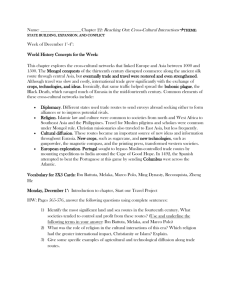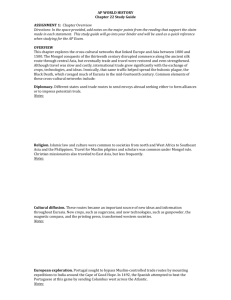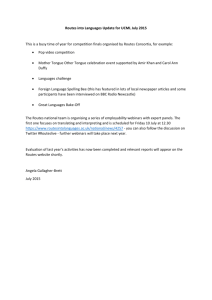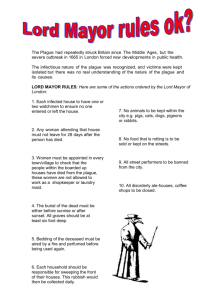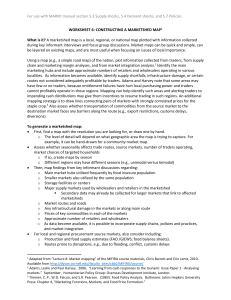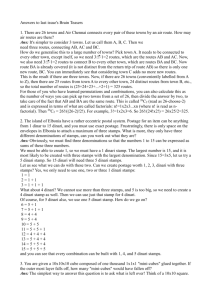Unit 3 Section 3
advertisement
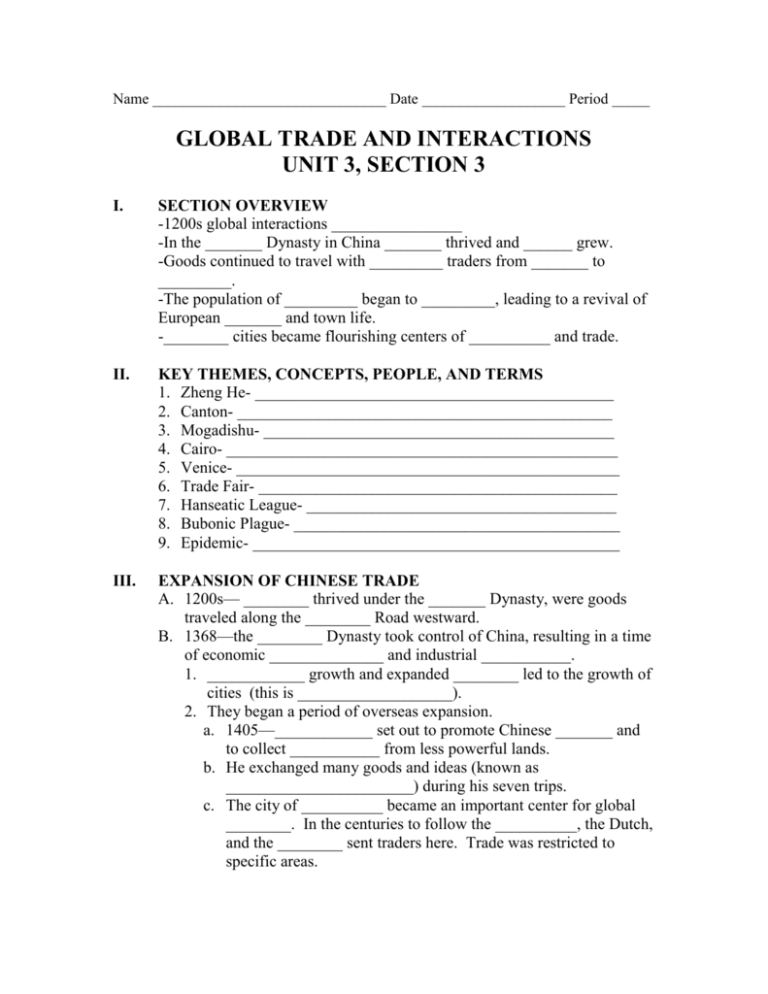
Name _______________________________ Date ___________________ Period _____ GLOBAL TRADE AND INTERACTIONS UNIT 3, SECTION 3 I. SECTION OVERVIEW -1200s global interactions ________________ -In the _______ Dynasty in China _______ thrived and ______ grew. -Goods continued to travel with _________ traders from _______ to _________. -The population of _________ began to _________, leading to a revival of European _______ and town life. -________ cities became flourishing centers of __________ and trade. II. KEY THEMES, CONCEPTS, PEOPLE, AND TERMS 1. Zheng He- ____________________________________________ 2. Canton- ______________________________________________ 3. Mogadishu- ___________________________________________ 4. Cairo- ________________________________________________ 5. Venice- _______________________________________________ 6. Trade Fair- ____________________________________________ 7. Hanseatic League- ______________________________________ 8. Bubonic Plague- ________________________________________ 9. Epidemic- _____________________________________________ III. EXPANSION OF CHINESE TRADE A. 1200s— ________ thrived under the _______ Dynasty, were goods traveled along the ________ Road westward. B. 1368—the ________ Dynasty took control of China, resulting in a time of economic ______________ and industrial ___________. 1. ____________ growth and expanded ________ led to the growth of cities (this is ___________________). 2. They began a period of overseas expansion. a. 1405—____________ set out to promote Chinese _______ and to collect ___________ from less powerful lands. b. He exchanged many goods and ideas (known as _______________________) during his seven trips. c. The city of __________ became an important center for global ________. In the centuries to follow the __________, the Dutch, and the ________ sent traders here. Trade was restricted to specific areas. IV. MAJOR TRADE ROUTES **THE TRADE ROUTES LINKED ASIA, AFRICA, and EUROPE RESULTING IN A GROWING INTERDEPENDENCE.** A. Across the Indian Ocean 1. This allowed for trade between _________ and East ________. 2. Trading centers, like ______________, developed and thrived. B. Overland Between East and West 1. This linked ________ with the Middle East, North Africa, and _________. Trade from China followed the ______ Road. C. Across the Mediterranean Sea 1. In the Middle East, ________ traders brought goods to ports in Egypt (like Cairo), Syria, and Turkey. In Egypt, goods could be transferred to _________ ships and they carried goods across the ___________________ Sea to _____________. V. RESURGENCE OF EUROPEAN TRADE -Europeans were more and more interested in trading with the East. -Improved methods of _____________ during the later __________ Ages led to an _____________ in population in Europe, leading to an ____________ in trade. A. Impact of the Crusades 1. One effect was _____________ European interest in the East. 2. Returning crusaders brought back goods. 3. Even though the Crusades failed in recapturing the ______ Land, ________ continued between the Middle East and Europe through ________. B. Italian City-States 1. Late 1300s—northern _________ cities became flourishing centers of __________ and _______. They had grown rich. 2. __________ took advantage of its location to control the valuable ________ trade with Asia. C. Trade Fairs and the Growth of Cities 1. Much trade in Europe went on at ____________, which occurred in towns where trade routes met on rivers. This led to the _________ of many cities. 2. Population in these towns ______________. D. The Hanseatic League 1. In northern _________ a group of traders and merchants began to join together to protect their interests (governments were still _______). 2. Mid-1300s, many German towns were members of the _____________ League. 3. Eventually, the League _______________ trade in the Baltic and North Seas. E. Portugal and the Spice Trade 1. ________ were very valuable during the ________ Ages. 2. They were used to __________ and flavor meats, used in ___________ and medicines as well. 3. The ________________ Empire disrupted trade routes, resulting in the need for new trade routes. 4. _____________ led the way. 5. The goal was to find a ________ sea route to the riches of the East. VI. THE PLAGUE AND ITS IMPACT -The __________ plague, also called the _______________, was a highly contagious disease spread by the _______ that lived on _____. -Shortly after the bite, people develop swellings and ______ bruises on their skin. -In a few days, victims died in agony. A. Outbreak in China 1. Early 1300s—the plague appeared in _________ cities, which were crowded at the time. It spread rapidly. B. A Global Epidemic 1. It was a devastating epidemic. 2. A resurgence in ________ that had been occurring since the 1100s helped to spread the __________. C. Effects of the Plague 1. POPULATION LOSSES—_____ million Chinese died. At its peak about _________ died a day in Cairo. In the end _________ of the European population had died. 2. ECONOMIC DECLINE—with the death of so many people, the ________ had devastated ___________ around the world. The people were left in a position to demand higher ______ and prices rose. Landowners and merchants tried to end this, but ___________ revolted. _______ was also disrupted. 3. SOCIAL AND POLITICAL CHANGE—___________ changes had _______ results, the strict class structure of earlier times began to break down. ____________ declined as _________ revolts weakened the power of landowners. Feudalism’s decline also led to the growth of new political systems (in __________ and __________ monarchs gained power). 4. CONFUSION AND DISORDER—some people questioned their ________ and the _________. MULTIPLE CHOICE QUESTIONS: Page 131-135 9. _______ 10. _________
